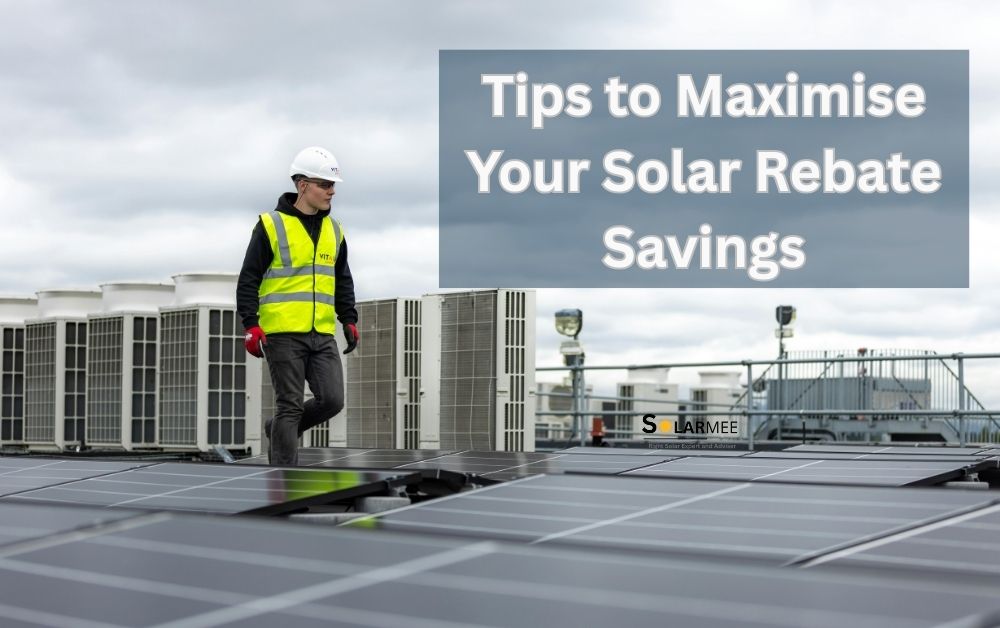Solar power utilization in the Northern Territory is going up at a great pace, with the region’s plentiful sunshine and rising environmental awareness being the two main driving factors. To qualify for solar installations and battery storage at a more affordable price, solar panel incentive schemes, especially the federal Small-scale Technology Certificates (STCs), and the newly launched Cheaper Home Batteries Program in July 2025, are playing a vital part.
This manual will define the rebates on hand, set the eligibility criteria, share some useful tips, and offer a fair review of the programs across the Northern Territory. The readers will receive the necessary information that will enable them to decide wisely on access to the government rebates and the optimization of their solar savings.
Understanding Solar Panel Rebate in the Northern Territory
Solar panel rebate is a discount funded by the government that lowers the initial cost of installing solar panels, thus making renewable energy more affordable and accessible. Residents of the Northern Territory mostly enjoy federal rebates such as the Small-scale Technology Certificates (STCs) that give a front-end discount based on the system size and location – for example, Darwin gets some of Australia’s highest rebates.
A new federal battery rebate starting 1st July 2025 will offer about 30% off on qualifying battery installations, thereby superseding the battery schemes specific to the NT. Energy retailers, as well as installers who have been accredited, are the ones that hold the key to the whole process since they are the ones who complete the necessary paperwork for the rebate as well as verify that the installation is up to the set standard, giving rebates as a direct reduction in the price to the customers, thereby easing the process.
Also Read: .Understanding Solar Panel Rebate in NSW (New South Wales)
Who is Eligible for Solar Rebates?
In the Northern Territory, the primary requirement for solar rebates is ownership of a property with proper documentation as proof. Currently, there is no strict income threshold under the federal programs, but the property must be a residential or business premises located in the NT. Solar systems that have been installed more than a year ago cannot be rebated, and the installed systems must be new ones.
Most of the rebates, including the federal Small-scale Technology Certificates (STCs), depend on the security of installation by Clean Energy Council (CEC)-accredited installers and the use of approved solar products to certify compliance.
One of the major confusions is between “who is eligible for solar rebate,” which means state-specific or program-specific rules like NT’s battery grants, and “solar panel rebate Australia eligibility,” which is the federal STC program accessible worldwide for qualified systems.

How to Claim Your Solar Panel Rebate in the Northern Territory
| Step | Action | Details |
| 1. Research Installers | Find approved installers | Choose Clean Energy Council (CEC)-accredited installers familiar with NT solar rebate requirements. |
| 2. Get Multiple Quotes | Compare different installation offers | Request several quotes to compare prices, services, and included rebates. |
| 3. Confirm Eligibility | Verify rebate eligibility | Confirm property ownership, system size limits, and new installation status under NT and federal rules. |
| 4. Apply for Rebate | Apply via the installer or the government portal. | Installers usually handle paperwork and rebate claims for easier processing. |
| 5. Install System & Rebate | Complete installation and rebate processing | Installer completes solar setup; rebate applied as an upfront discount or rebate payment. |
Benefits of Solar Rebates for Northern Territory Households
How good it is that we now have solar rebates in the Northern Territory. Just think that these solar panel subsidies slash the initial solar installation cost by a significant amount, which automatically opens the door to renewable energy for more households in the NT. For instance, about a 6.6kW standard system is eligible for nearly $2,554 worth of rebates because of the local Small-scale Technology Certificate (STC) zone rating in the NT.
This grant shortens the payback period and increases the return on investment (ROI); consequently, the homeowners become their own electricity bill savers quickly. Besides that, solar installation via subsidies would be a great contribution to the renewable energy goal of the Northern Territory and would also help in cutting down carbon emissions. There are some real-life examples showing how the locals have slashed their expenses deeply.
Comparing Northern Territory Rebates with Other States
The Northern Territory is offering very good federal rebates for solar energy in Australia. Small-scale Technology Certificates (STCs) give a saving of about $2,200 for a 6.6kW system in Darwin because it has a very high zone rating. In contrast with Victoria, where the Solar Homes Program is giving state rebates up to $1,400 for the interest-free loans and additionally up to $1,400 for the solar system, making it a total of $2,800 savings, the Northern Territory is mainly relying on the federal incentives.
Also, Queensland is giving moderate rebates that are between $1,000 and $1,200, combined with regional incentives and feed-in tariff adjustments. If we talk about affordability, the NT is the best because of its generous federal rebates and doubled peak feed-in tariffs, which are excellent for financial returns.
However, program accessibility can be limited by the number of accredited installers, that are less than in Victoria, which has widespread coverage and additional support. Queensland‘s incentives are getting better, but they are still not as good as those in other states.

Real Reviews & Experiences from Northern Territory Households
Northern Territory families say that solar rebates are a good thing generally, and they talk about large cost savings and the fact that the rebate application process was easier, as the installation was done by an accredited installer. M
Many have been able to lower their electricity bills to a great extent after the installation of solar panels, which has been subsidized by federal STC rebates and the new battery rebate program.
Nevertheless, a few customers talk about some issues, e.g., the slow processing of paperwork, and the confusion that the latest changes in the rebate rules may cause the installers. Even though there are some issues, the program still plays a big role in leading people to install solar panels and giving them monetary benefits.
This impartial viewpoint indicates that the rebate program still has great value, as local administrative 0personnel are coping with the logistical complexities of the program in their work.
Future of Solar Rebates in the Northern Territory
The solar rebate’s future in the Northern Territory seems very bright, largely due to the persistent federal actions such as the Small-scale Technology Certificates (STCs) scheme, which will remain in place until 2030 with annual declines. From July 1, 2025, the federal Cheaper Home Batteries Program will give a 30% rebate on a qualifying battery system; hence, a further solar-battery uptake will be facilitated.
The NT government’s battery subsidy has already finished, but there are still good incentives for renewables in the form of federal rebates and new programs for electric vehicles and virtual power plants. The solar installation will probably continue to grow as the federal government keeps supporting this initiative.
The application processes become more accessible; however, the trend could be toward the deployment of energy storage and smart grid technologies to achieve the stability of the electricity grid, according to the experts in the industry.
Also Read: What is a Solar Panel Rebate?
Conclusion
Solar rebates in the Northern Territory are a great way to save a lot if you are a qualifying homeowner. These are mainly brought about through various federal programs like the Small-scale Technology Certificates (STCs) and the new solar battery rebate that starts from July 2025.
The eligibility criteria are dependent on house ownership and the installation of approved, new solar or battery systems done by an accredited installer. The benefits include reduced initial costs, shorter return on investment periods, and assistance towards the NT’s clean energy targets. Some hints from professionals to get a reputable installer, and as far as rebates are involved, you may get more if you combine them.
The reviews tell of some inconveniences with the process of handling paperwork and waiting times due to the confused mindset of the installer, in which they received instructions, but the overall effect of the programs is to provide a strong saving of costs. Due to the possibility of a decrease in rebate values over time, it is advisable to check the criteria and take prompt action.
Call a certified solar energy professional for your solar energy panel rebate in the Northern Territory today.
Solarmee.com empowers homeowners, businesses, and installers with clear, expert solar guides, product insights, and Learn how to make smarter solar decisions.




